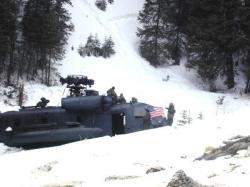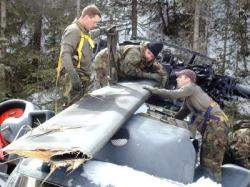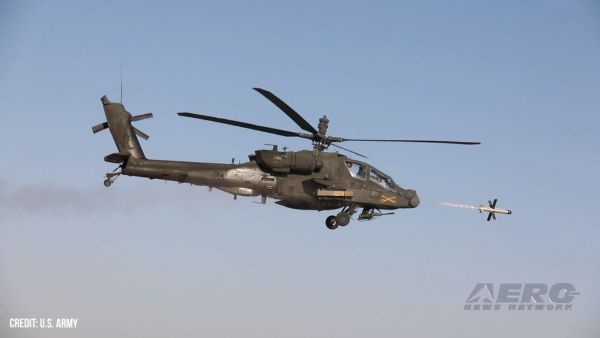Fourteen Miles Through the Mountains, in February...
 Twelve people from the 58th Special Operations
Wing at Kirtland AFB (NM) made Air Force history recently with the
recovery of a downed MH-53J Pave Low helicopter from the San Juan
Mountains in Colorado.
Twelve people from the 58th Special Operations
Wing at Kirtland AFB (NM) made Air Force history recently with the
recovery of a downed MH-53J Pave Low helicopter from the San Juan
Mountains in Colorado.
The unprecedented operation, which began Feb. 9, was launched
almost a month after the helicopter's hard landing during a
civilian rescue operation near the city of Durango. The cause of
the mishap is under investigation.
"This operation went as well or better than anyone could have
expected," said Chief Master Sgt. Mark Self, the 58th Special
Operations Group maintenance superintendent who managed the
recovery operation. "Everyone, from our hand-picked team of
dedicated crew chiefs to the contractors tasked to transport the
damaged helicopter, deserve a pat on the back for their efforts.
Not only did we retrieve a valuable and limited military asset
during this operation, but we also did it in a way no one has ever
attempted as far as we know."
The recovery operation's unique nature lies in its namesake,
Bobsled, which describes in one word the method used to transport
the helicopter from its month-long resting place in an isolated
ravine to a staging area at the foot of the mountains.
Essentially, the helicopter was raised by a crane, placed onto a
modified flatbed trailer that functioned as a sled and pulled 14
miles along a skid trail through the mountains. While that
certainly makes the effort stand out from past aircraft recovery
operations, it is the altitude and rugged terrain that presented
the most obvious challenges.
 "We exhausted [a particularly poignant word, at
9700 feet --ed.] virtually every other option to remove the
helicopter," said Senior Master Sgt. David Haugh, a recovery team
member. "The crash site's altitude of 9,700 feet elevation
precluded us from lifting out the Pave Low with another helicopter
because of the downed helicopter's size and the potential strain on
the lifting helicopter's engines. The rugged terrain made removing
it in a piecemeal fashion unfeasible."
"We exhausted [a particularly poignant word, at
9700 feet --ed.] virtually every other option to remove the
helicopter," said Senior Master Sgt. David Haugh, a recovery team
member. "The crash site's altitude of 9,700 feet elevation
precluded us from lifting out the Pave Low with another helicopter
because of the downed helicopter's size and the potential strain on
the lifting helicopter's engines. The rugged terrain made removing
it in a piecemeal fashion unfeasible."
Each member of the 12-man recovery team can vouch for the rugged
terrain of which Haugh speaks. After rising at dawn and riding
almost two hours in an all-terrain snow vehicle to get within a
mile of the crash site, the team hiked back and forth along snowy,
icy, occasionally muddy, and sometimes treacherous paths for more
than week.
Once there, they had a mere six hours of daylight each day to
work and to prepare the helicopter for transport, which included
finding and gathering crash debris in waist-deep snow, removing
rotor blades and fuel tanks and, with the help of a crane, lifting
an 8,000-pound gear box from the downed 8600-hp Pave Low.
"The location, terrain and position of the helicopter presented
its share of challenges, but overall I think the operation went
quite well. It could've been much worse," said Master Sgt. Jackie
Powell, lead maintainer for the recovery team. "The weather was
very good for us except for one day of heavy snow, and, in the end,
even that worked in our favor because it provided more traction for
the bulldozers pulling the sled."
Powell, whose 12 years as a dedicated crew chief for MH-53Js
made him the most experienced member of the recovery team, said
this has been the most difficult and challenging of five recovery
operations he has participated in, but it was perhaps the most
rewarding as well.
 "It's special to be a part of something that's
never been done before, and I think the entire team knows and
appreciates that," Powell said. "I picked these guys because of
their ability, enthusiasm and work ethic. They didn't disappoint
me. Each one of these guys worked unselfishly and with tremendous
dedication to accomplish this recovery. I really believe that
picking each of them was the best decision made during this entire
operation."
"It's special to be a part of something that's
never been done before, and I think the entire team knows and
appreciates that," Powell said. "I picked these guys because of
their ability, enthusiasm and work ethic. They didn't disappoint
me. Each one of these guys worked unselfishly and with tremendous
dedication to accomplish this recovery. I really believe that
picking each of them was the best decision made during this entire
operation."
Team members appreciated the opportunity as well.
"This is a once-in-a-lifetime chance," said recovery team member
Airman 1st Class Rocco Pietrofesa. "I gained some valuable
experience that's going to help me throughout my career. I'm proud
to be part of this team and to make such a great contribution to
the Air Force."
The helicopter was transported to a staging area Feb. 22, so the
recovery team members could continue their work on the damaged Pave
Low helicopter before it begins its five-day trek across the
country to the Naval Depot at Cherry Point (NC), where it will be
salvaged and subsequently returned to Kirtland.
[Thanks to Ron Gibson 58th Special Operations Wing Public
Affairs; Air Education and Training Command News Service --ed.]
 Aero-News: Quote of the Day (09.27.25)
Aero-News: Quote of the Day (09.27.25) ANN's Daily Aero-Term (09.27.25): Hold For Release
ANN's Daily Aero-Term (09.27.25): Hold For Release NTSB Final Report: Seawind 3000
NTSB Final Report: Seawind 3000 Classic Aero-TV: F/W R/C Models-Horizon Hobby's Stunning Small A/C Capabilities
Classic Aero-TV: F/W R/C Models-Horizon Hobby's Stunning Small A/C Capabilities ANN's Daily Aero-Linx (09.27.25)
ANN's Daily Aero-Linx (09.27.25)





